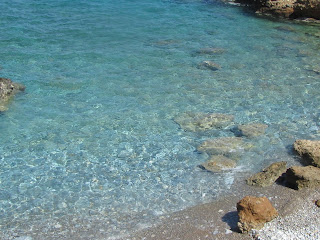There are so many stories I could share about my time in
Crete, I don’t know where to begin! I’ll warn you right away: this is going to
be a long post! To start off, I’ll just mention a few things about the island
itself and about the cities I traveled to while I was there. Crete is the fifth
largest island in the Mediterranean and the largest of all the Greek islands.
It has been under the control of many civilizations and empires over the course
of its history and its art and architecture reflect these many cultural
influences. Therefore, not only did I get to see the very oldest Bronze Age Minoan
ruins but also Venetian and Ottoman structures and art work. Over the course of five days, our group
visited three of Crete’s major cities: Heraklio, Rethymno and Chania. Each of
these cities is along the northern coast of Crete and contains a beautiful mix
of mountain and sea views. In order to arrive on Crete, our group left the port
of Piraeus in Athens and traveled by ferry (overnight) to the port at Heraklio.
The ferry ride itself was a new experience for me so I was already so excited
to begin the trip! We arrived on Crete early in the morning on Tuesday and
launched right in to our busy schedule.
On the Ferry!
Day one began at
the Minoan palace and city of Malia. Although it is difficult to picture now,
Malia was once a thriving town during the Bronze Age. It was initially built around
1900 BC and was rebuilt several times only to be devestated once and for all in
1450 BC. I still get chills every time I step on a walk-way where I know people
stood some four thousand years ago. After visiting the site of Malia our group
continued to a second Bronze Age city, that of Gournia. This site, much like
Malia, contained many of the standard features of a Minoan city such as a
central court. Below are a few pictures from both archaeological sties.
A giant Pithos!
After a long ferry ride and two hikes around Malia and
Gournia, our group was ready for some relaxtion. We headed to the small
(modern) town of Pacheia Ammos where we stopped for a late lunch and a swim in
the Mediterannean! There is just nothing like floating in the clear blue water
of the Mediterannean while taking in the beautiful mountain views.
Day two of our Cretan journey centered around a visit to
the most famous Minoan palace: Knossos! Having learned the most about this
particular site, I was so thrilled to be able to see it for myself. In addition
to walking around the enormous palace complex, we also visited the
Archaeological Museum where I got to see the Leaping Bull mosaic that I studied
in my very first art history class at Tufts (see pic below). Much of the
original archaeological site of Knossos was reconstructed by the archaeologist
Arthur Evens so many of the pictures I took include views of his reconstructed
columns and mosaics. The original columns were made of wood and thus do not
survive.
Knossos!
After seeing many Minoan palaces and cities, our group
spent much of the last two days of our trip visiting more recently built
structures. These included two Venetian Fortetsa castles, one in Rethymno and
one in Chania, as well as a Venetian monastery. The Venetians occupied Crete
during the 12th-17th c. AD and were eventually ousted by the Ottomans during
the 17th century. It is still possible to see traces of both Venetian and
Ottoman occupation on Crete. One example of this can be found on the original
Venetian fortetsa in Rethymno where a church was converted by the Ottomans into
a mosque. Evidence of traditional Turkish bath houses, called Hammams, can also
be seen in Chania.
Venetian fortress (above)/ Venetian church (below)
Another Venetian fortress (above)/ Church turned mosque (below)
Church at the Arkadi Monastery (above)/ Turkish hammam (below)
It would be impossible to recount all of my experiences
in Crete, but I’ll leave you with a few of my favorites: walking down 4,000 year
old steps, swimming in the Mediterannean, visting the only remaining synagogue
on Crete, holding a 3,500 year old pomegrante, seeing a reconstruction of a
Minoan ship...and many many more!
Hope you enjoy!
Sam



















Hello I am Ibrahim ASQUARRAY Morocco with 10 years of experience, typically navigates the Atlas and the Moroccan desert, walking tours are organized camel through Morocco. Various circuits: mountains, desert expeditions in 4 × 4, camel rides, luxury camping in the desert ... * We want to work with those who can work together and strive to provide better service to customers and work around the kingdom to meet with clients and provide a different experience. We toured the Atlas Mountains and the desert of Morocco, and we'v been organizing trips all around the mountains and desert are organized as complementary services A and sports associations.
ReplyDeleteWelcome In High Atlas Morocco
www.moroccan-montains.com